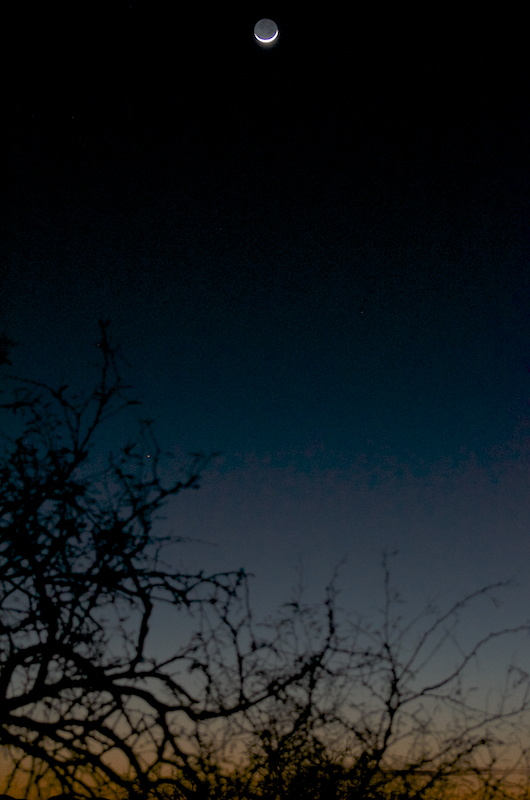
Crescent Moon, NGC660 Polar-Ring Galaxy
Posted: 14 January 2013
Opened the observatory on Sunday, 13 January 2013, at 1800 MST, 43°F. The sky was partly cloudy with high thin clouds in much of the sky. Viewed Jupiter, 77X, at 1805 MST; four moons were visible but the view of the planet was hampered by the thin clouds. Viewed the crescent moon, 77X, at 1808 MST. Earthshine was nice in the 8" telescope. I then used the 2" 9mm 100° eyepiece (222X); seeing was not good but occasionally the views along the terminator were nice.
This is the moon captured with the D7000 DSLR using the 70-300mm VR lens, f/5.6, 1/10sec, ISO 1600, 300mm, and cropped some from the full-frame image:

The next photo, f/4.5, 1/10sec, ISO 1600, 70mm, shows the moon in the fading twilight. If you look closely you can see Mars through the tree limbs at the left.

I then began preparing to re-image NGC660, a "polar-ring" galaxy. I had imaged it on previous sessions, but I wanted to try a 10 minute exposure this night with the hope of showing the ring better. With the moon waxing, this would be the last opportunity to capture it for awhile. The camera was mounted at prime focus of the 8" LX200-ACF using an Off-Axis Guider. I did a focus test exposure on a star using the Bahtinov Mask. At 1916 MST, I located a good guide star and did a framing test exposure of NGC660, 1 minute, ISO 6400. Framing was acceptable. I then began waiting for the moon to set. The temperature in the observatory was now 29°F. Finally, with the moon no longer a factor, I began imaging at 1956 MST. This is a guided, 10 minute, ISO 6400, full-frame image:

NGC660 and the "polar-ring" are visible just right of center. At the upper left is the galaxy IC148. Several other small faint galaxies are visible in the image.
I did two 10 minute exposures this night and stacked them using Lynkeos. This is the result, with an effective exposure of 20 minutes, showing the "polar-ring" (oriented horizontally), passing in front of and behind the galaxy:

Imaging was completed at 2020 MST and the observatory was closed at 2038 MST, 27°F.
Comments are welcome; use the Comments section below, or you can Email Me. Thanks.
Go to the previous report.
Return to the Cassiopeia Observatory Home Page.